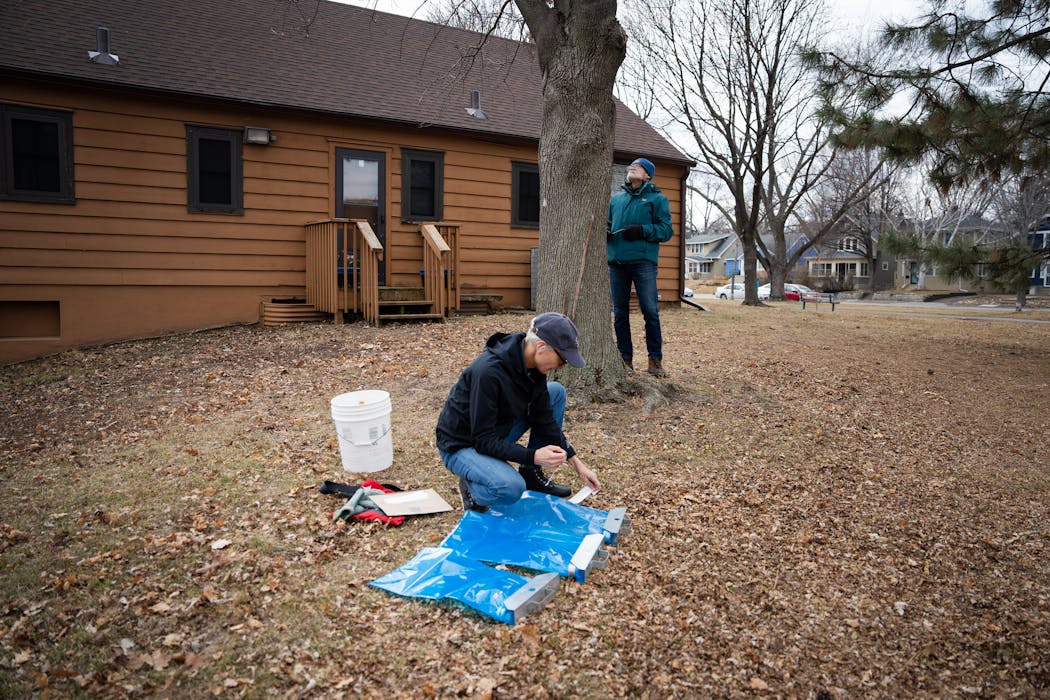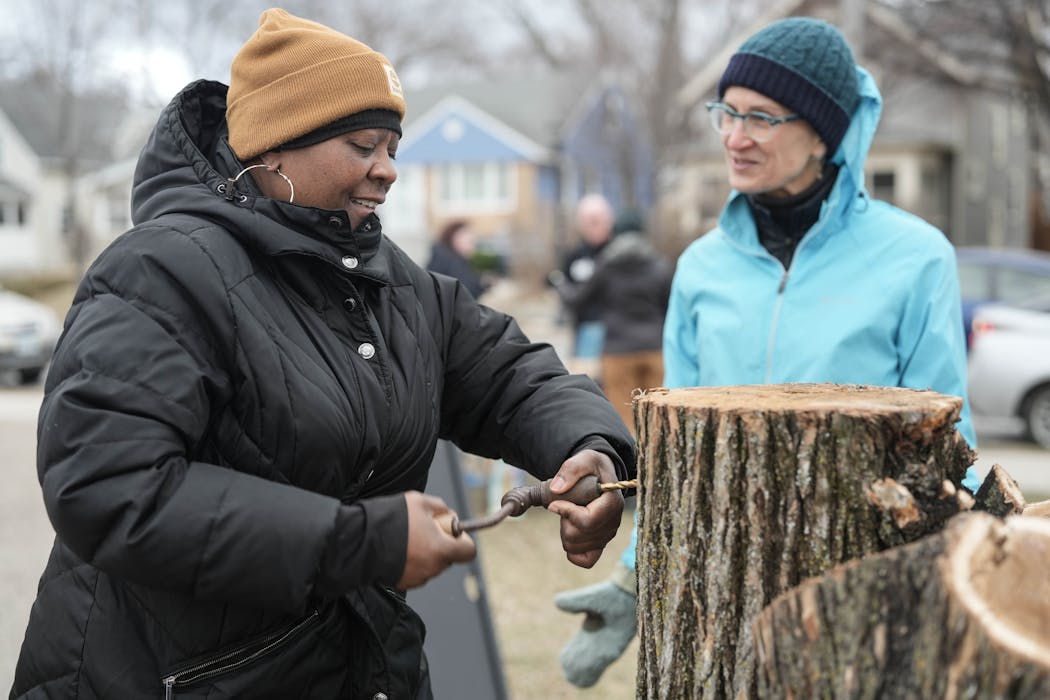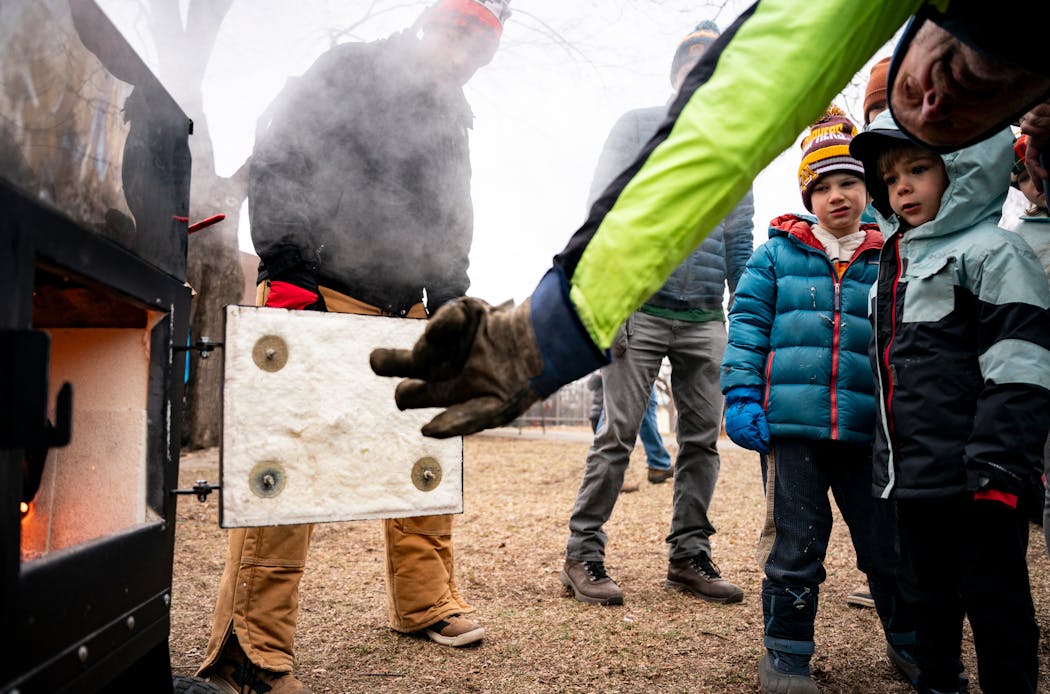The sap erupted at the end of January, two months earlier than normal. There had been no rain, so the rivulets of ice coursing between the furrows of King Park's maple trees could only be frozen sap. It came apart in the hand with a slightly glutinous texture, and tasted distinctly sweet.
The sudden start of syruping season launched the members of the Urban Sap Tap project into action. Holes were drilled in trunks, spiles hammered 2½ inches deep, plastic receptacles hung with the group's new logo, including a QR code with information about their new Park Board pilot program.
For the past six winters, an ad hoc collective of people who live in the King Field neighborhood of south Minneapolis have harvested sap from the maple trees in their own yards, getting together in the park to boil their spoils down into syrup. This winter they got the Park Board's permission to tap the park's maples, too, after convincing the forestry department they could do it without damaging the trees.
At the peak of sap production, Sarah Linnes-Robinson, a longtime neighborhood association leader, would empty the bags in the park at least once a day into 5-gallon buckets. She compared sap tapping to ice dipping on the lakes, another niche and quintessentially Minnesotan activity that wasn't sanctioned by the Park Board until residents pushed for it.
"I think the Park Board is maybe trying to listen more to citizens and how they want to use the urban environment," Linnes-Robinson said.
By bringing the rustic tradition of maple tapping out of backyards and into a major city park, the group hopes to share their hobby more widely — including with neighbors who don't have maples and those who don't own land.
The whole exercise is bit like making stone soup. Maple sap contains 98% water and just 2% sugar, meaning 40 gallons of sap cooks down into about 1 gallon of syrup. A single maple tree isn't going to produce much, and no one household in the city has enough space for a sugar bush, or maple orchard. It quite literally takes a village to make enough syrup to serve the neighborhood a proper pancake breakfast, which the Urban Sap Tap group puts on in March to celebrate spring's arrival after the trees bud and the sap dries. They raise just enough money to finance the following year's tap.
But is there a conservation angle? Just a subtle one derived from the oft-quoted logic of Senegalese forester Baba Dioum: "In the end we will conserve only what we love, we will love only what we understand, and we will understand only what we are taught."
Urban Sap Tap member Steve Brandt and Aaron Flanders, King Park's recreation supervisor, pondered the connection between caring for a tree and collecting food from it as they tapped six more maples in the park in early February. Brandt used a hand drill to make the hole and a turkey baster to flush it with diluted bleach.
"It gets you outside at the time of year when most people aren't doing recreation outdoors, when the snow's starting to go, the ice skating rinks have turned to mush and it's not bicycling weather unless you're hard-core," he said. "It does put you in touch with trees. You learn to read a tree and see how the tree heals itself."
Maple tree tapping was invented by Indigenous groups, who associated it with the nascent spring, when it's still freezing at night but the days are starting to get warmer. These conditions cause the tree's cells to expand and contract, sucking water up from the roots overnight and building pressure in the trunk when temperatures rise during the day. Some trees practically gush sap when that pressure gets overwhelming, like a cow badly needing to be milked.
"It's hard to ask a tree to get a firsthand opinion, but it's nature's way of releasing pressure," said Gary Wyatt, agroforestry educator with the University of Minnesota Extension. "I would say it's somewhat healthy for the tree."
Whether the trees are resilient enough for tapping following several years of drought and an unseasonably warm winter was a question posted on many a maple syruping forum this year. When urban residents asked friends on the reservation whether they're tapping, the answers ran from abstention out of an abundance of caution to snapshots of pots full of sap boiling on the stove. There's no absolute right answer — every tree owner has to make the decision for themselves, said Wyatt.
South High School's All Nations program, which has a long-running tradition of tapping the boulevard trees next to the school, had a bye year. District spokeswoman M.A. Rosko said it was a weather-related decision.
Native kids who grow up in the city may never have gotten the chance tap a tree and collect their own sap for syruping, said Gloria Iacono of the Native American Community Development Institute. She's the food sovereignty manager of Four Sisters Farm at 2839 17th Av. S., which has a plot dedicated to sugar maple saplings that will one day contribute to the farm's mission of rebuilding Indigenous food systems in the urban environment.
That'll be many years in the future, when the saplings reach the 10 inches in girth required for tapping. In the meantime, the NACDI and foraging instructor Haleigh Ziebol are trying to recreate in East Phillips the network of privately owned maple trees that the Urban Sap Tap group started in King Field. They hope that grassroots organizing will one day unlock park trees for tapping in the Phillips community as well.
"I don't know of any other operations that are doing this in an urban environment," said Iacono. "I think maybe part of that is, again, access to trees ... You need to be able to tap a significant amount of trees, which is kind of why doing it in a community setting is so cool. If everyone pools their resources, you can find enough maple trees in your area, and people can bring the sap that they have and make something together."
The Urban Sap Tap project hosted their annual pancake breakfast on March 16 and served 250 people, or roughly 100 more than last year, according to an informal utensil poll. As clouds of water vapor billowed from a new evaporator paid for by a park innovation grant, families sampled the product of last year's tap. It was a dark, viscous syrup, its complex sweetness the result of sap taken from different types of maples growing in the neighborhood.
"Hopefully we can replicate this for other areas," said Peter Jaeger, a citywide nature programmer for the Park Board who has long advocated for tapping the trees in King Park. "It's been received pretty well, so as we continue, hopefully there'll be more and more interest."
Minnesota DFL wants faster clean energy permits, but some are wary of shortcutting public input

NASA hears from Voyager 1, the most distant spacecraft from Earth, after months of quiet

The House votes for possible TikTok ban in the US, but don't expect the app to go away anytime soon

Why you should donate clothing: It (probably) won't end up at the dump






